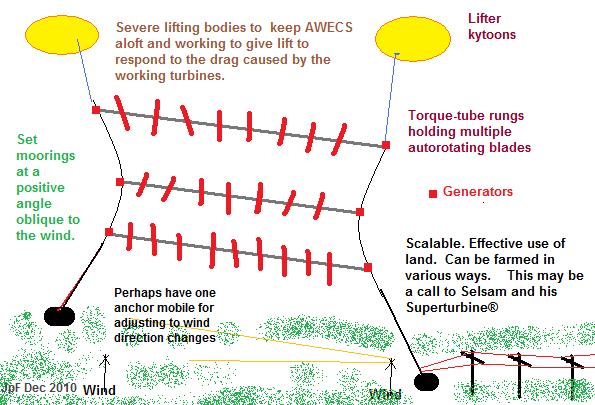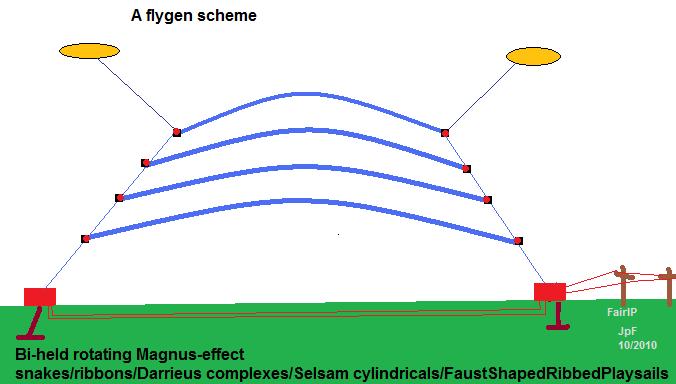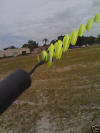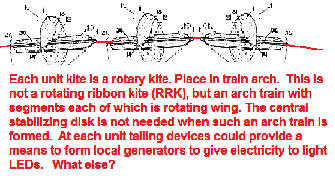|
Ribbon-arch-rotating kites The top edge of ribbon moves downwind.
Generally these kites are ribbon-like with the entire ribbon or its sections rotating with axis traverse to the wind while being held with two kitelines; i.e. flip-winging. Think of extended Magnus-effect kite with more flexible wing. SkyBow, Ribbon kite, rotating playsail, rotating-ribbon arch kite, rotating-ribbon kite, These are autorotation kites using the Magnus-effect. Magnus effect rotating kites that have the rotation axis bluntly normal to the stream. Think of a rainbow in the sky that is autorotating as the rainbow interacts with the wind. Double-ended terrain-held VAWT might be considered the superset that holds flexible rotating-ribbon auto-rotating kites as a subset. "anti-gravity rope" (but they are not round ropes). Jim Mallos and Tony Frame have worked in RRKs. Magnus-Robins effect. Spin rates? Section spin rates? Ribbon design for arch sections? Anchors. Groundgen RRK system? Micro-skygen RRK? Texture? Shape? Curves? Skybow rotary kite. Ribbon rotary kite. Rotor arch. Rotating arch kite system. Skybow Rotary-Wind Engine. Skybow rotary arch kite. Autorotating ribbon kite. Mr. Big. Photos. Challenges: design, sizing, limits, sectioning, uses, scientific description, trappable torque, tensions, rotation speeds, limits, wind speeds, width, precise specifications, safety, tensions, launching alternatives, landing alternatives, farms, free-falling moorings, spar-separated free-falling moorings, tugged by two parallel flying aircraft, etc. Invite furthering by all. Flying ribbons. Sectional swivels? Swivels at mooring. Interference in a farm of such kites? What are the stall and re-start behaviors of particular designs? Success stories? Bringing in nanotech materials? Laminate materials (say Kevlar and foam, say foam and carbon-tube foundation, etc.). One dealer claims:
How much energy may be obtained from rotating-ribbon kites? How scalable is this technology? World records for kite-energy from this category of kites? Double-ended terrain-held VAWT might be considered the superset that holds flexible rotating-ribbon auto-rotating kites as a subset. Is there an AWECS niche here? The low L/D might even be helpful for mining torque for driving generators. See related article here. Niche application of rotating ribbon kites? Advertising. Decoration. Celebration. Kite-energy production. Play. Recreation. Bird scaring might be explored with this type of kite. Sound maker. Education. Section the long bow where sections rotate at their own speeds and with their own end swivels might be explored to limits of scale and function. Consider central pilot lifter kytoon or kite for a vast array of rotating ribbons with groundgens at each of the many mooring points, each mining a bit of the torque. What are the limits to such consideration? Consider using two separate kites with one tugging left and the other tugging right; stretch a rotating ribbon kite RRK between the kitelines of the two kites. How far could this arrangement be taken? Consider also incremental stiffening of the ribbon to the point the ribbon becomes a stiff rotating wing held between the two L-R kites or kytoons. Or held by terrain; then we approach http://tech.groups.yahoo.com/group/AirborneWindEnergy/message/663 matters, which see; such get into Darrieus matters, terrain-held Superturbine snakes, etc. Non-rotating ribbons, playsails? Such are close to non-rotating sled arches, paragliders, etc. We put these in contrast with rotating ribbons that positively rotate (more than zero rotate). Example: http://www.ipass.net/lewsther/kites/ribbon.jpg Example also: free-falling kite that is a manned paraglider using Jalbert parafoil as wing. The non-rotating wings have a potential of better L/D over the rotating ribbon kites.
|
Contrast systems that are
not RRK
flexible ribbons, but are still two-mooring arches of rotating elements:
|
Consider replacing the ribbon with a torque tube while setting the two
anchors with one downwind some; mount multiple autorotating HAWTs on the
torque tubes. Have LTA severe lifting kytoons at left and right for
lifting the complex. Have several rungs of the static ladder while the
element rungs are fully dynamically rotating. Generators could be at the
left and/or right ends of each rung. Is this a call to Selsam and
his SuperTurbine® with sky serpent rungs of a tall multi-rung
ladder to the skies. Multiply the shown system to
kitefarm.  http://www.movinglikewater.com/Images/super_turbine.jpg
|
|
Kite Lines article by Steve McKerrow and Valerie Govig The high-arching Skybow Is it a rotor kite? An arch ribbon? Neither? Both? Kite Lines, Winter 1997-98, starts on page 52 and continues. I have study copies form the source of Jim Mallos photobucket site. Posted some links in AWES forum on April 27, 2013. Study file in Kites/ at EKS. |
| Bullroarer AirborneWindEnergy/message/9099 |
|
SKYBOW Image warm up for a SkyBow musing:
Roy Mueller shares a SkyBow musing: "What is the bar set at.... What is it's highest level? |


 JpF
JpF

